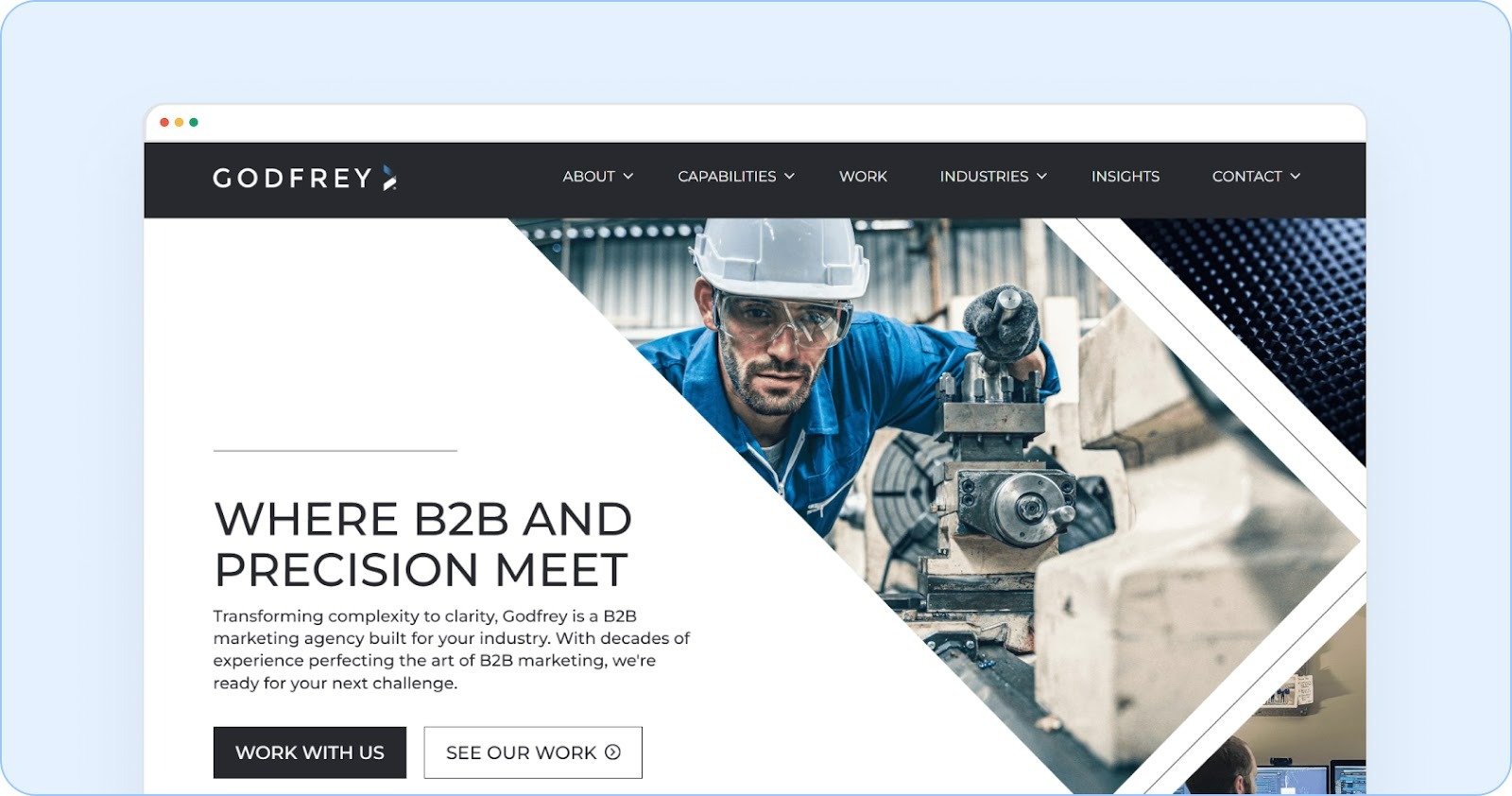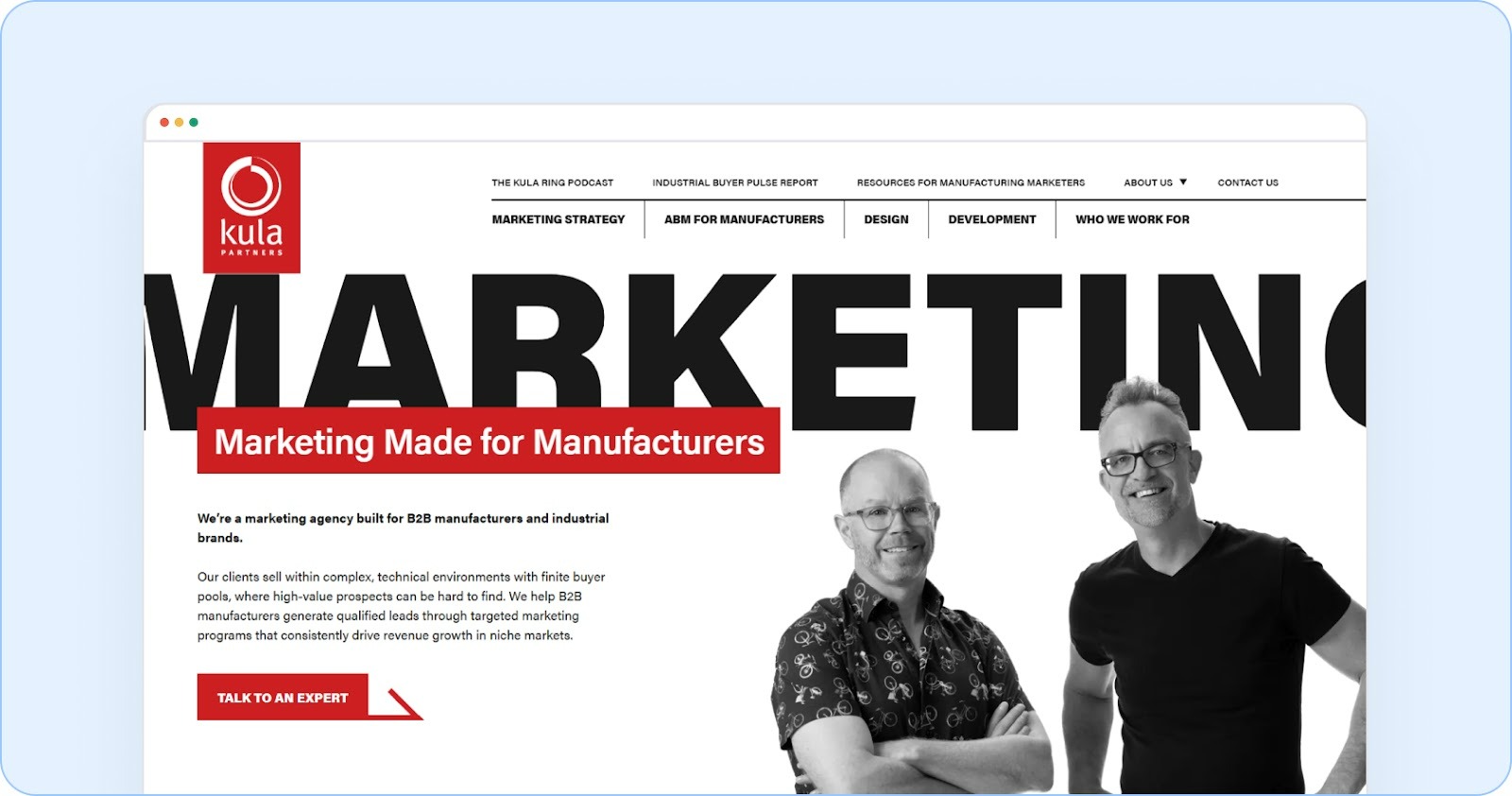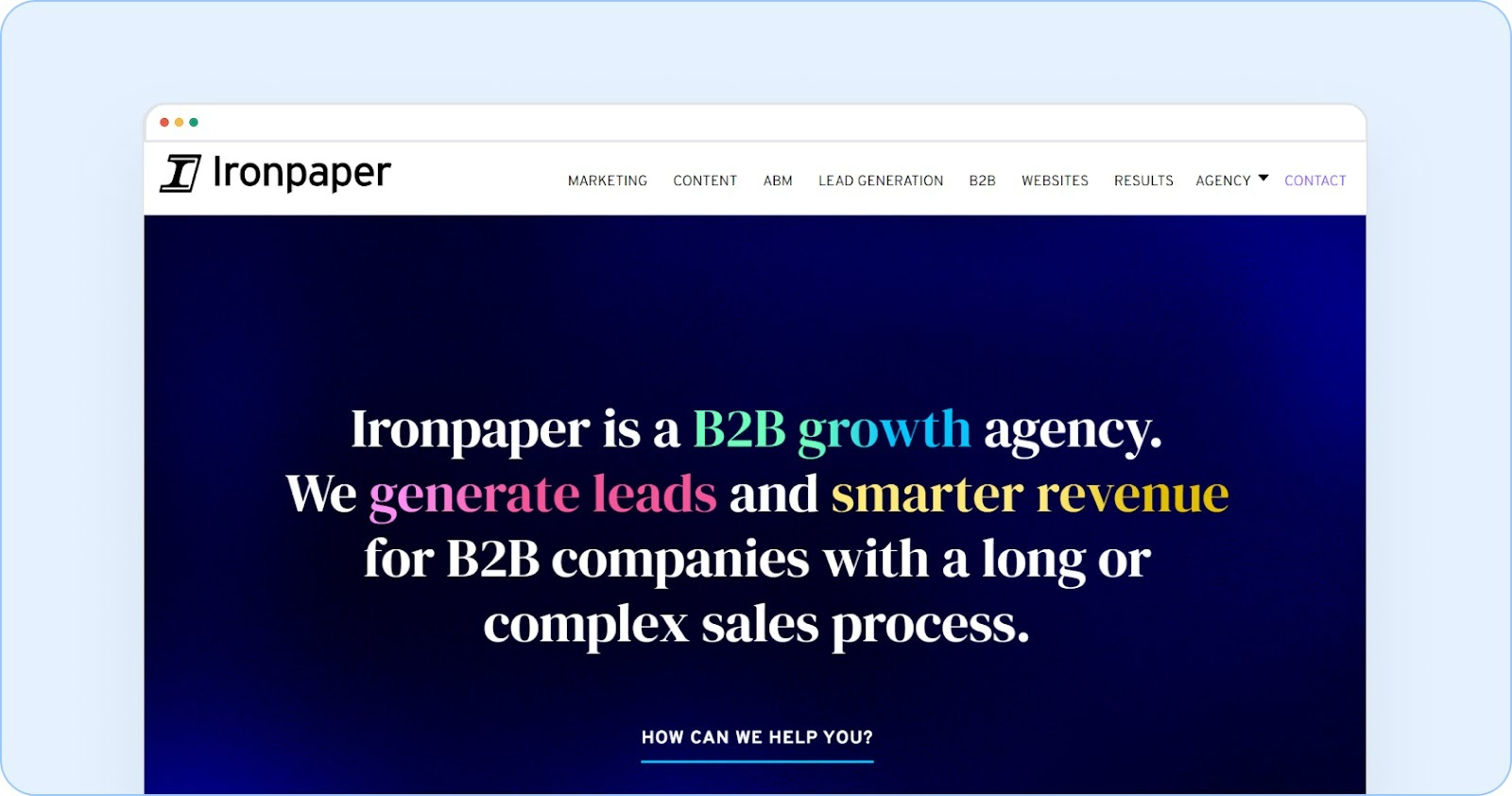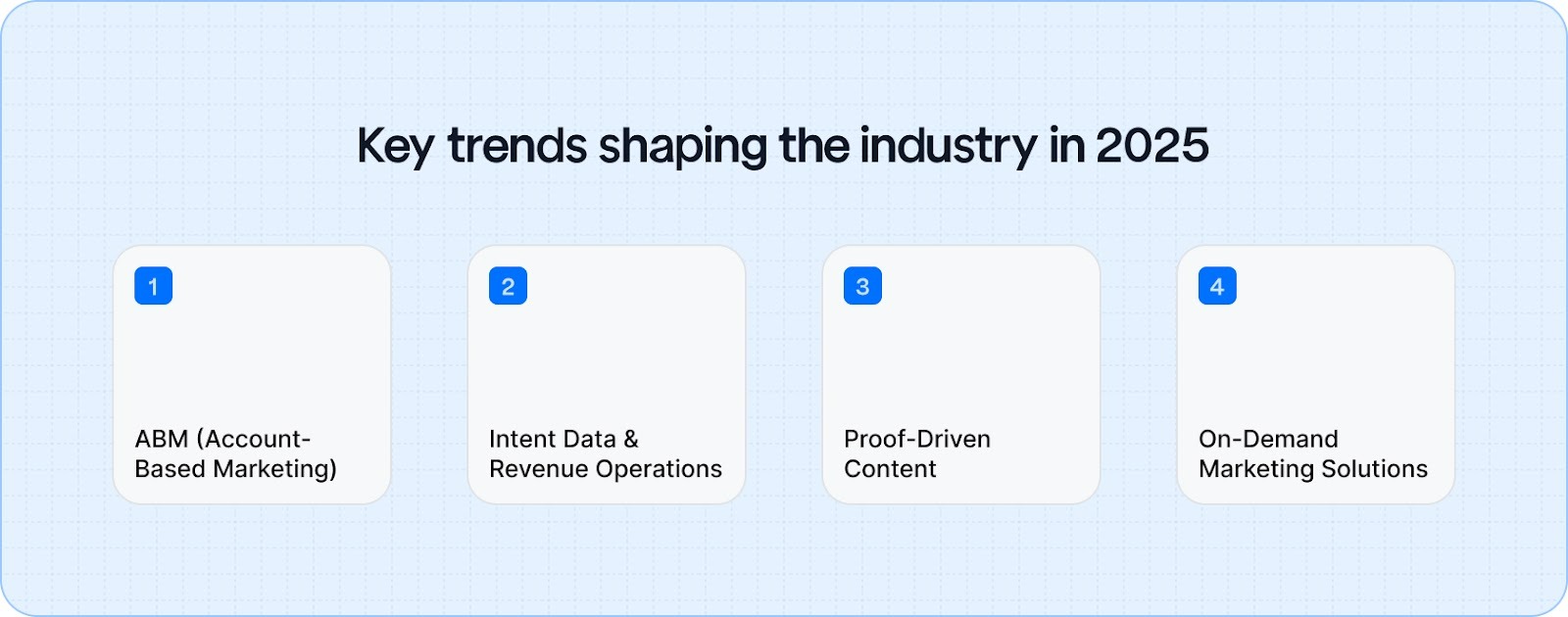Selling in the manufacturing sector means offering precision and high-cost machinery that demands a deeper understanding than the average buyer can provide.
The challenge is finding the right leads: engineers, procurement managers, and decision-makers who value technical complexity. Wasting time and budget on unqualified leads who miss industry nuances is a real frustration.

B2B marketing must focus on exact matches. If your strategy fails to connect with those who prioritize precision over price, the cost goes beyond ad spend.
This article will guide you in creating a strategy that targets ideal buyers and drives meaningful, results-driven conversations.
1. Gushwork

Gushwork provides a faster and more efficient way for manufacturers to grow their marketing efforts. Unlike traditional agencies that can be slow and expensive, Gushwork offers flexible, on-demand teams that fit directly into your existing workflow.
These teams handle everything from targeting the right leads to improving your website's search rankings, without the need for lengthy setup or high costs.
Specialty: On-demand B2B marketing support
Best For: Manufacturers needing scalable solutions without extra hires
Standout Feature: Flexible teams that work seamlessly with your in-house staff
2. Gorilla 76

Gorilla 76 specializes in simplifying complex industrial processes into straightforward, impactful stories.
They specialize in making marketing meaningful for manufacturers, converting industry jargon and technical complexity into narratives that attract qualified leads and drive genuine pipeline growth.
Specialty: Industrial content + ABM strategy
Best For: OEMs, contract manufacturers, and systems integrators
3. Flying V Group

Flying V Group focuses on performance-driven SEO, turning technical specifications into easily searchable and high-ranking content.
They aim to generate measurable RFQs by using keyword strategies and conversion-focused landing pages.
Specialty: Technical SEO + PPC for engineers
Best For: Component manufacturers and industrial suppliers
4. Elevation Marketing

Elevation Marketing combines creativity with data-driven strategies, offering brand development, paid campaigns, and trade show support in one integrated approach.
Their focus is on helping manufacturers with complex marketing needs streamline their efforts for consistent scalability.
Specialty: Full-service marketing for industrial enterprises
Best For: Large manufacturers with complex channel ecosystems
5. Godfrey

Godfrey has been helping manufacturers in automation, materials, and process industries tell their stories.
They combine traditional credibility with modern digital marketing strategies to help manufacturers connect with the right audience.
Specialty: Brand strategy + thought leadership
Best For: Established manufacturers modernizing legacy brands
6. Kula Partners

Kula Partners focuses on inbound marketing, helping manufacturers turn website visitors into potential leads.
They create persona-driven content and set up automated sales processes to support long-term growth.
Specialty: Inbound marketing + HubSpot automation
Best For: Mid-market manufacturers building sustainable lead funnels
7. Straight North

Straight North focuses on performance marketing for manufacturers, tracking key metrics like cost per lead, conversion rate, and pipeline value.
They ensure every campaign is aligned with measurable success and contributes to your business goals.
Specialty: Performance marketing + analytics
Best For: Manufacturers demanding measurable ROI and full transparency
8. Beyond Borders Marketing

Beyond Borders Marketing helps international manufacturers enter the U.S. market with expertise in localization and go-to-market strategies.
They adapt technical language and compliance messages to create campaigns that connect with domestic buyers, making the transition smoother.
Specialty: U.S. market expansion + cross-border positioning
Best For: Global manufacturers entering or scaling in the U.S.
9. Ironpaper

Ironpaper uses an agile approach to marketing, running sprint-based campaigns that combine demand generation, content, and web development for quick results.
They help manufacturers grow their revenue and customer base with continuous testing and optimization.
Specialty: Demand generation + ABM
Best For: Industrial tech and manufacturing innovators
10. AccuraCast

AccuraCast helps manufacturers expand their global reach through effective SEO and PPC campaigns, ensuring accurate translations of keywords and product descriptors.
Their expertise in international markets allows them to efficiently convert global leads.
Specialty: Multilingual performance marketing
Best For: Export-oriented manufacturers and global engineering firms
11. 310 Creative

310 Creative specializes in aligning complex sales cycles with marketing automation, ensuring that every stage of the customer journey is optimized for maximum revenue impact.
Their data-first approach connects content, ABM, and revenue operations, revealing exactly what drives deals and how to scale faster.
Specialty: CRM-integrated ABM + RevOps
Best For: Growth-stage manufacturers scaling revenue systems
12. LabsMedia

LabsMedia leverages AI-driven marketing to help manufacturers gain a competitive edge.
Using predictive ad modeling and automated keyword clustering, they optimize campaigns to be more efficient and targeted, enabling manufacturers to stay ahead of the competition.
Specialty: AI-powered SEO + media
Best For: Digitally advanced manufacturers seeking predictive insights
The State of U.S. Manufacturing Marketing in 2025
Marketing in the manufacturing sector has undergone a significant transformation. What once relied heavily on trade shows and brochures has evolved into a data-driven ecosystem.
This shift allows manufacturers to make more precise, strategic decisions, aligning their marketing efforts with the complex demands of the modern industrial buyer.

Key trends shaping the industry in 2025:
- ABM (Account-Based Marketing): Manufacturers are now focusing their efforts on key accounts, targeting high-value companies with tailored strategies to engage decision-makers.
- Intent Data & Revenue Operations: Manufacturers are leveraging data to better understand buyer intent and optimize their revenue operations, ensuring marketing efforts align with sales cycles.
- Proof-Driven Content: Content has moved from generic product promotion to proof generation. High-quality assets like ROI calculators, spec comparison tools, and customer case videos are becoming essential in the decision-making process.
- On-Demand Marketing Solutions: Partnerships between in-house teams and on-demand providers are helping manufacturers scale their marketing efforts without the need for additional full-time hires. This allows for flexibility and speed in a constantly evolving marketplace.
The winning formula in 2025 is a balance of speed, specialization, and measurable ROI.
Manufacturers are choosing flexible marketing solutions, like Gushwork’s adaptable teams, to quickly adjust to their needs and get results faster than with traditional agencies.
The Manufacturing Marketers Leading The Charge
Manufacturers today face an evolving landscape where traditional marketing approaches no longer deliver the results needed for growth. The future favors agility, integration, and operational efficiency, and that’s exactly what Gushwork offers.
Gushwork’s flexible teams plug into your sales process, taking care of tasks like ABM, SEO, and campaign execution, delivering faster, measurable results than traditional agencies.
- Traditional marketing is too slow to keep up with today’s demand for agility and speed.
- On-demand, ROI-driven marketing is the future for manufacturers.
- Gushwork’s flexible marketing teams provide manufacturers with the speed and efficiency they need to scale their marketing efforts effectively.
FAQs
Q1: What is B2B marketing for manufacturers?
A1: B2B marketing for manufacturers involves promoting products or services to other businesses, focusing on long-term relationships, technical specifications, and addressing the unique needs of industrial clients.
Q2: How can manufacturers generate more B2B leads?
A2: Manufacturers can enhance lead generation by identifying their ideal customer profiles (ICPs), understanding buyer personas, and creating targeted marketing strategies that address specific pain points.
Q3: Why is digital marketing crucial for manufacturers?
A3: Digital marketing is essential as 70% of B2B buyers research solutions online before engaging with sales teams. Without a strong online presence, manufacturers risk losing potential clients early in the decision-making process.
Q4: What are the key components of B2B marketing services for manufacturers?
A4: Key components include market research, content creation, lead generation, sales enablement, SEO, PPC advertising, and email marketing, all tailored to meet the specific challenges of industrial clients.
Q5: How do I choose the right B2B marketing agency for my manufacturing business?
A5: Select an agency with industry expertise, a proven track record in manufacturing marketing, and a strategic approach that aligns with your business goals and target audience.
Q6: What role does SEO play in B2B marketing for manufacturers?
A6: SEO is vital as it helps manufacturers rank higher in search engine results, making it easier for potential clients to find their products or services, thereby increasing organic lead generation.
Q7:How can manufacturers measure the ROI of their B2B marketing efforts?A7: Manufacturers can measure ROI by tracking key performance indicators (KPIs) such as lead quality, conversion rates, and sales growth, and by attributing these metrics to specific marketing activities.




















.webp)








.webp)



.svg)







.svg)